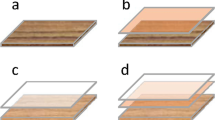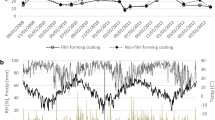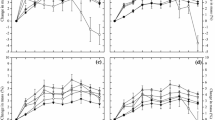Abstract
The natural weathering of surface treatments was compared at four sites and on five wood species; beech, spruce, Scots pine (sapwood), Douglas fir and dark red meranti, for 24 months. The surface treatments were: impregnating stain, film forming stain, pigmented acrylic latex paint and pigmented alkyd paint (solvent based). Despite substantial differences between the four locations, the results of the exposure differed only little. Spruce was shown to be a substantially better substrate for surface treatments than beech or Scots pine, though Douglas fir and meranti were best of all. The impregnating stain weathered uniformly, whereas the film forming stain cracked and flaked, leading to growth of blue stain fungi. Both acrylic latex and alkyd paint showed little or no damage after 2 years of weathering. The dampening effect of surface treatments on the natural changes of wood moisture content was initially quite good for the impregnating-and the film-forming stains, but both lost their efficiency after approximately 12 months. The protection conferred by acrylic latex was somewhat better, though possibly not sufficient for external joinery requiring dimensional stability. The highest level of moisture exchange damping efficiency was shown by the alkyd paint.
Zusammenfassung
Das Bewitterungsverhalten und die natürliche Alterung von Oberflächenbehandlungen wurden auf fünf verschiedenen Holzarten—Buche, Kiefer (Splint), Fichte, Douglasie und Meranti—an 4 europäischen Standorten während 24 Monaten geprüft. Die Oberflächenbehandlungen waren: Imprägnierlasur, Dickschichtlasur, Acryl-Dispersion und konventioneller Alkydanstrich. Trotz recht verschiedenen Klimaten unterscheiden sich die Bewitterungsresultate nur wenig. Die Fichte erwies sich als ein bedeutend besserer Anstrichträger als Buche oder Kiefer (Splint); Douglasie und Meranti waren jedoch der Fichte weit überlegen. Die Imprägnierlasuren wurden ziemlich einheitlich ausgewaschen; die Dickschichtlasuren sind im Gegensatz dazu eher gerissen, was infolge Unterwanderung des Anstrichfilmes zur Verblauung geführt hat. Sowohl die Acryl-Dispersion wie der Alkydanstrich waren nach 2 Jahren Freibewitterung noch intakt. Die Dämpfung der Feuchtigkeitsänderungen waren für Imprägnier- und Dickschichtlasuren anfänglich recht gut, doch beide hatten nach 12 Monaten diese Eigenschaft weitgehend eingebüßt. Der entsprechende Schutz durch die Acryl-Dispersionen war wohl etwas besser, aber immer noch ungenügend für Außenbauteile, welche eine gute Dimensionsstabilität erfordern. Die beste Feuchteschutzwirkung erbrachten die Alkyd-Anstriche.
Similar content being viewed by others
Author information
Authors and Affiliations
Rights and permissions
About this article
Cite this article
Roux, M.L., Wozniak, E., Miller, E.R. et al. Natural weathering of various surface coatings on five species at four european sites. Holz als Roh-und Werkstoff 46, 165–170 (1988). https://doi.org/10.1007/BF02619544
Issue Date:
DOI: https://doi.org/10.1007/BF02619544




